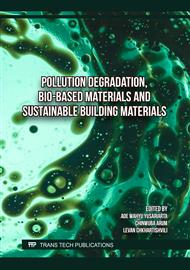p.3
p.11
p.19
p.25
p.31
p.41
p.47
p.59
Chitosan Membranes Filled by Silica from Palm Oil Fuel Ash (POFA) with Low Methanol Permeability for Direct Methanol Fuel Cell Application
Abstract:
Polymer Electrolyte Membranes (PEM) is an important component in a Direct Methanol Fuel Cell (DMFC) system that has a primary function as a proton conductor and separator between a cathode and anode. Due to the awareness of the comprehensive methanol crossover issue in the commercially available Nafion membrane, however, the main parameter of PEM for DMFC is low methanol permeability. The chitosan-based inorganic hybrid membrane is a promising organic–inorganic hybrid for the development of high-performance PEM. The study of composite membranes as PEM was initiated with the synthesis of silica from POFA (palm oil fuel ash). Using the phase inversion technique, the chitosan was mixed with silica filler in an acetic solution to produce Ch/Silica composite membrane. Scanning Electron Microscopy with Energy Dispersive X-Ray Spectroscopy (SEM-EDX) analysis shows that pure silica has been successfully synthesized from POFA and can interact with chitosan in the layer of the membrane structure which is supported by the Fourier Transform Infrared Spectroscopy (FTIR) spectra results. Water uptake shows a value of 75%, while methanol uptake with a low value of 52%. The addition of silica gives the membrane the ability to reduce methanol crossover as indicated by the low value of methanol permeability of 0.00027 mg cm2s-1. However, this membrane has good proton exchange performance as indicated by the Ion Exchange Capacity value of 1.56 mmol g-1. These results indicate that the composite membrane of chitosan with silica from POFA has the potential as PEM in direct methanol fuel cell applications.
Info:
Periodical:
Pages:
3-10
Citation:
Online since:
October 2025
Keywords:
Price:
Сopyright:
© 2025 Trans Tech Publications Ltd. All Rights Reserved
Share:
Citation:


